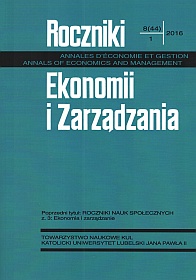The Theories Describing Board of Directors Roles
Abstract
There are several theories describing board of directors roles. This are in particular: managerial hegemony theory, agency theory, resource dependence theory, institutional theory, stakeholder theory, stewardship theory, class hegemony theory. In the paper the position of board of directors in corporate governance system has been shown and the theories have been presented describing its roles. Some conclusions were also formulated concerning validity of presented theories in the current Polish corporate governance system.
References
Adams R.B., Hermalin B.E., Wiesbach M.S., (2010), The Role of Boards of Directors in Corporate Governance: A Conceptual Framework and Survey, “Journal of Economics Literature” Vol. 48, No. 1, pp. 58-107.
Boulton W.R., (1984), The Board of Directors: Beware of those triggers that cause board change, “Journal of Business Strategy” Vol. 1, No. 5, pp. 84-92.
Bozec R., (2005), Boards of Directors, Market Discipline and Firm Performance, “Journal of Business Finance & Accounting” Vol. 32, No. 9-10, pp. 1921-1960.
Brennan N., (2006), Boards of Directors and Firm Performance: is there an expectations gap?, “Corporate Governance” Vol. 14, No. 6, pp. 577-593.
Carroll W.K., Alexander M., (1999), Finance Capital and Capitalists Class Integration in the 1990s: Networks of Interlocking Directorships in Canada and Australia, “Canadian Review of Sociology & Anthropology” Aug., Vol. 36, Issue 3, pp. 331-354.
Certo T.S., Dalton C.M., Dalton D.R., Lester R.D., (2008), Boards of Directors’ Self Interest: Expanding for Pay in Corporate Acquisition?, “Journal of Business Ethics” No. 77, pp. 219-230.
Cohen J.R., Krishnamoorthy G., Wright A.M., (2008), Form versus Substance: The Implications for Auditing Practice and Research of Alternative Perspectives on Corporate Governance, “Auditing: A Journal of Practice & Theory” Vol. 27, No. 2, pp. 181-198.
Dhaouadi K., (2012), Effect of corporate governance on the top management compensation, “Journal of Economics and International Finance” Vol. 4, No. 1, pp. 18-29.
Frankforter S.A., Berman Sh,L., Jones Th.M., (2000), Boards of Directors and Shark Repellents: Assessing the Value of an Agency Theory Perspective, “Journal of Management Studies” Vol. 37, No. 3, pp. 321-348.
Garratt B., (1999), Developing Effective Directors and Building Dynamic Boards, “Long Range Planning” Vol. 32, No. 1, pp. 28-35.
Heller M.F, Jr. (1972), The Board of Directors: Legalistic Anachronism or Vital Force, “California Management Review” No. 14, pp. 24-30.
Hillman A.J., Dalziel Th., (2003), Boards of Directors and Firm Performance: Integrating Agency and Resource Dependence Perspectives, “Academy of Management Review” Vol. 28, No. 3, pp. 383-396.
Johnson J.L., Daily C.M., Ellstarnd A.E., (1996), Boards of Directors: A review and Research Agenda, “Journal of Management” Vol. 22, No. 3, pp. 409-438.
Johnson R.A., Hoskisson R.E., Hitt M.A., (1993), Board of Directors Involvement in Restructuring: The Effect of Board Versus Managerial Controls and Characteristics, “Strategic Management Journal” No. 14, pp. 33-50.
Kosnik R.D., (1987), Greenmail: A Study of Board Performance in Corporate Governance, “Administrative Science Quarterly” Vol. 32, No. 2, pp. 163-185.
Kroll M., Walters B.A., Wright P., (2008), Board Vigilance, Directora experience, and Corporate Outcomes, “Strategic Management Journal” Vol. 29, pp. 363-382.
Lawal B., (2012), Board Dynamics and Corporate Performance: Review of Literature, and Empirical Challenges, “International Journal of Economics and Finance” Vol. 4, No. 1, pp. 22-35.
Mac C.L., Brennan N., O’Higgins E., (1998), The ‘old boys’ Network and Irish company boards, “Accountancy Ireland” Vol. 30, No. 3, pp. 6-9.
Mizruchi M., (1983), Who Controls Whom? An Examination of the Relation Between Management and the Boards of Directors in Large American Corporations, “The Academy of Management Review” Vol. 8, No. 3, pp. 426-435.
Pawlak M., (2012), Hidden (unpublic) knowledge about interlocking directorates in Polish Joint Stock Companies, The 1st OBEGEF conference: Interdisciplinary Insights on Fraud and Corruption, Porto, Portugal, September 13-25.
Pfeffer J., (1972), Size and Composition of Corporate Boards: The Organization and its Environment, “Administrative Science Quarterly” Vol. 17, No. 2, pp. 218-228.
Stevenson W.B., Radin R.F., (2009), Social Capital and Social Influence on the Board of Directors, “Journal of Management Studies” Vol. 46, No. 1, pp. 16-44.
Tuttle B., Dillard J., (2007), Beyond Competition: Institutional Isomorphism in U.S. Accounting Research, “Accounting Horizons” Vol. 21, No. 4, pp. 387-409.
Wang J., Dewhirst D.H., (1992), Boards of Directors and Stakeholder Orientation, “Journal of Business Ethics” Vol. 11, pp. 115-123.
Williamson O.E., (2007), Corporate Boards of Directors: In Principle and in Practice, “The Journal of Law, Economics, & Organization” Vol. 24, No. 2, pp. 247-272.
Young G., I., Stedham Y., Beekun R.I., (2000), Boards of Directors and the Adoption of a SEO Performance Evaluation Process: Agency – and Institutional – Theory Perspectives, “Journal of Management Studies” Vol. 37, No. 2, pp. 277-295.
Zahra Sh.A., Pearce J.A., (1989), Boards of Directors and Corporate Financial Performance: A Review and Integrative Model, “Journal of Management” Vol. 15, No. 3, pp. 291-334.
Copyright (c) 2016 Roczniki Ekonomii i Zarządzania

This work is licensed under a Creative Commons Attribution-NonCommercial-NoDerivatives 4.0 International License.


